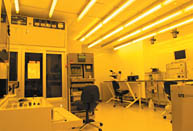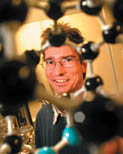It's a Nano World


Inside the 'clean room' at the new Tools for Nanoscience facility.

Physics Professor Peter Grütter with a model of a 'buckyball,' a molecule that is a new form of carbon.
Look - nano-pants are 30% off at the Bay," says Peter Grütter, waving a catalogue advertising garments coated with a "nano-material" purporting to resist dirt - "but I don't know if it's really nano," he says. These days, the prefix draws a lot of attention. "The hype is so high that people are putting 'nano' on all sorts of things. We have to distinguish the real nanotechnology from nano-pretenders." Grütter, a professor in the Physics department, is the real thing, one of a core of McGill researchers exploring the various manifestations and applications of nanoscience and nanotechnology.
High-tech apparel is by no means the only nanotechnology application out there. Recently, Hewlett Packard's television advertisements have drawn attention to their research into the use of nanotechnology in the creation of faster, more precise printers. The company is also at work on a computer chip using molecules as transistors; eventually, such a chip could hold a billion transistors, whereas today's fit no more than a measly 50 million.
In other realms, nanotechnology operations are already in action - for instance, in creating stronger, lighter metal alloys for use in automobiles and aircraft. Biomedical applications are also in the works, from systems that could deliver drugs to the body more effectively to those that facilitate the use of prosthetic implants. Indeed, hardly a research area exists which doesn't have the potential to incorporate nanotechnology applications: from energy to agriculture to pharmaceuticals, nanotechnology research has been drawing the bright young minds.
What is Nano?
As a result, what constitutes the truly nanotechnological can be difficult to pin down. "If you talk to one hundred people in nano research, you'll get two hundred definitions," says Grütter - who obligingly offers two. First, the materials being dealt with must be less than a micrometre - itself pretty small, at one-millionth of a metre (there are a thousand nanometres in a micrometre, and a billion in a metre). In fact, nanostructures are usually much smaller than the 999-nanometre cut-off point: the structures are often built from few enough atoms that they can be counted individually.
"Secondly," says Grütter, "a nanosystem has to have properties that are different because of its size. For example, even at the micrometre level, electrical conductivity through a wire follows classical principles. But if we shrink the wire to a few nanometres in diameter, conductivity changes. Classical laws no longer apply, quantum mechanical effects kick in, and things become weird, strange or interesting, depending on your point of view," he explains. At this point, electronics becomes nanoelectronics, which is creating a buzz thanks to its potential application in smaller, faster computer systems.
Work Wins Acclaim
Grütter's nano research has followed a number of paths, but much of his work involves designing and building the sophisticated microscopes that enable scientists to watch clearly what atoms are up to in nanostructures. Once the tiny molecules can be visualized, they can be experimented upon. He has also carried out research into regulating conductivity at the molecular level, and has collaborated with medical researchers from the McGill University Health Centre to understand the processes through which neurons conduct the impulses that enable us to feel pain.
His innovative and energetic work has won him plenty of acclaim, including a 2001 Steacie Fellowship, one of the country's top science and engineering prizes awarded by the Natural Sciences and Engineering Research Council (NSERC), and he has been the nation's nano-chief since June 2002, when he was named Research Director of the NSERC Nano Innovation Platform and placed in charge of coordinating a national strategy for nano research. The federal government is serious about increasing nanotechnology in Canada, directing over $150 million in recent years to building a national research infrastructure. And Nano-Québec, established in 2001, will do the same thing provincially, thanks to $15 million committed to it by the provincial government.
McGill is also in the process of developing a nano strategy and has quickly become the top place in Canada for nano research. Over a year ago, Grütter and other McGill researchers across disciplines - including physics, chemistry, life sciences, chemical engineering, and mining, metals and materials engineering - joined to create the McGill Institute for Advanced Materials (MIAM).
"The term 'advanced materials' covers a wide range," says Bruce Lennox, Chair of Chemistry. "It really designates an approach to materials as much as the materials themselves." So an "advanced material" could be an innovative metal alloy, a plastic composite, or even a new form of concrete. "Basically, it involves looking at performance characteristics of a material and trying to enhance them," says Lennox. Nanotechnology provides an important way to enhance materials, and is thus expected to assume an important part of MIAM's mandate.
"MIAM is a formalization of a community that already existed here," says Lennox. "A lot of material research was going on at McGill, but was isolated in departments." MIAM addresses this isolation by bringing together scientists from different areas to share ideas and, ultimately, collaborate on projects; through its association with Nano-Québec, MIAM will also lead to further exchange with researchers around the province.


